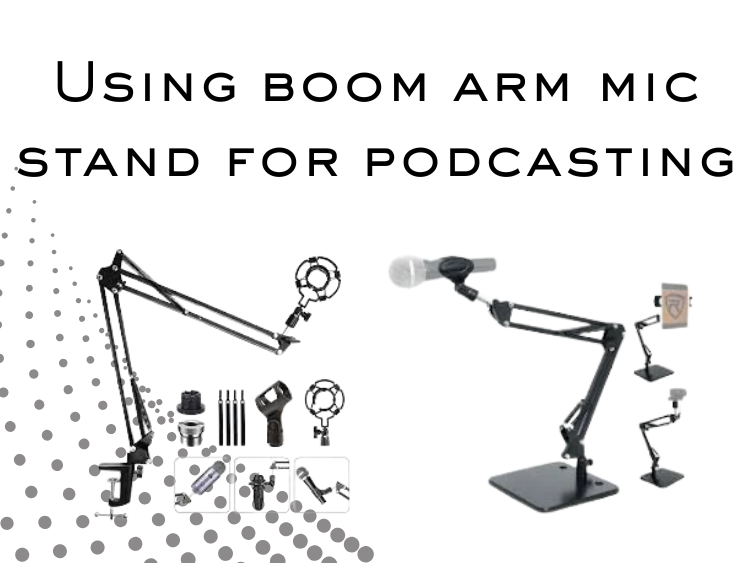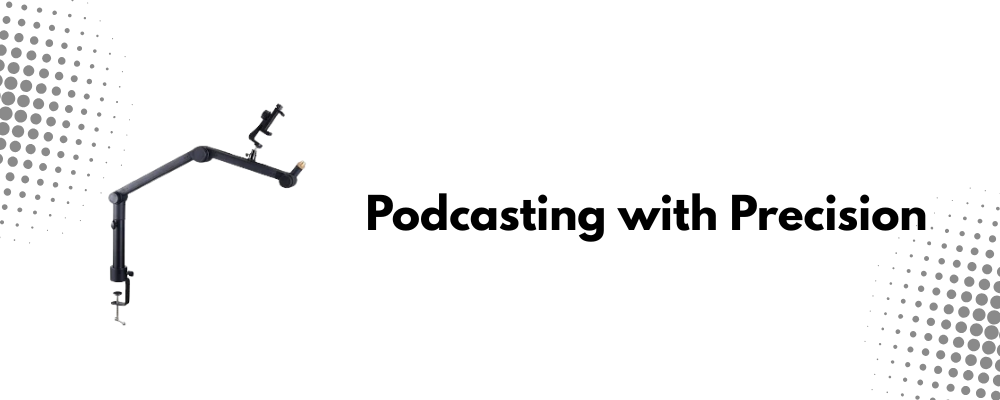A boom arm stand isn’t just an accessory—it’s a game-changer for podcasting. Whether you’re recording in a professional studio or a home setup, mic placement matters more than you think.
A poorly positioned mic picks up unnecessary noise, forcing you to edit out distractions. A boom arm stand eliminates this hassle, keeping your mic steady and at the perfect height.
No more awkward desk clutter. No more struggling with mic angles. Just smooth, hands-free recording with crisp, consistent audio.
If you’re new to podcasting and unsure how to set up a boom arm stand, this guide has you covered. Let’s break it down step by step, so you can sound professional from day one.
Why a Boom Arm Stand is Essential for Podcasting
A boom arm stand isn’t just about convenience—it directly impacts sound quality and recording efficiency. It keeps your microphone in the optimal position, reducing unwanted noise and making your setup more professional. Here’s why it’s a must-have for podcasters.
Keeps the Mic Stable and Prevents Vibrations
Even the best microphones pick up vibrations from desk bumps or keyboard clicks. A boom arm isolates your mic from these disturbances, ensuring cleaner audio with fewer unwanted sounds.
Improves Audio Quality by Maintaining a Consistent Mic Position
Handheld or desktop stands often lead to inconsistent mic placement, affecting sound levels. A boom arm allows precise positioning, keeping your voice clear and evenly captured throughout your recording.
Frees Up Desk Space for a Clutter-Free Setup
With a fixed stand, your mic takes up valuable desk space. A boom arm lifts the mic off the surface, giving you more room for notes, a mixer, or even just a comfortable workspace.
If you are confused between a boom arm stand and a straight stand for your podcasting experience, read our guide on are boom mic stands better than straight stands.
Choosing the Right Boom Arm Stand
Not all boom arm stands are the same. The right one depends on your mic’s weight, desk setup, and adjustability needs. Before buying, consider these key factors.
Weight Capacity and Compatibility
Boom arms have weight limits. Heavier mics, like the Shure SM7B, require sturdy stands, while lightweight condensers work with most entry-level options. Check specifications before purchasing.
Mounting Options: Clamp vs. Desk Insert
- Clamp-on mounts attach to the edge of a desk and are easy to reposition.
- Desk-insert mounts require drilling but provide a cleaner, more stable setup.
Choose based on your workspace and whether you need portability.
Adjustability and Reach
Some boom arms rotate 360 degrees, while others have limited movement. A fully adjustable arm lets you position the mic effortlessly, avoiding awkward angles or unnecessary strain.
Built-in Cable Management for a Clean Look
Loose cables can get in the way and look messy. Some boom arms have built-in cable channels, while others use external clips. A tidy setup prevents snags and keeps your space organized.
Setting Up Your Boom Arm Stand for the Best Results
A well-positioned boom arm stand enhances comfort and improves audio clarity. Proper setup ensures your mic stays secure, reducing unwanted noise and making adjustments effortless. Here’s how to get it right.
Positioning the Boom Arm for Optimal Sound
The mic’s position affects how your voice is captured.
- Angle the boom arm slightly above or below your mouth to reduce plosive sounds.
- Keep the mic 6–12 inches away for clear audio without distortion.
- Avoid placing the mic directly in front of your mouth to prevent breath noise.
Securing the Microphone Properly
- Use the correct thread adapter to ensure a tight, stable fit.
- If your mic is heavy, counterbalance the boom arm to prevent sudden movement.
- Adjust tension knobs carefully to keep the arm in place without over-tightening.
Managing Cables for a Tidy and Safe Setup
Loose cables create clutter and can affect mic stability.
- Use built-in cable channels or Velcro ties to keep cords secured.
- Route cables along the boom arm to prevent accidental tugs.
- Avoid wrapping cables too tightly, which can damage internal wiring.
Common Mistakes to Avoid
Even with a high-quality boom arm, improper handling can lead to issues like instability, poor positioning, or even damage. Avoid these common mistakes.
Over-Tightening Joints, Reducing Adjustability
Boom arms rely on flexible joints for smooth positioning. Over-tightening can make adjustments difficult and wear out the joints over time. Tighten just enough to hold the mic steady.
Extending the Boom Too Far, Causing Tipping
Stretching the arm beyond its weight capacity or extending it too far without support can make it unstable. Keep the base secure, and don’t overload the arm.
Ignoring Weight Limits, Leading to Wear and Tear
Heavy microphones require sturdy boom arms. Using a stand that isn’t built for your mic’s weight can lead to sagging or breakage over time. Always check compatibility before mounting.
Maintaining Your Boom Arm Stand for Longevity
A boom arm stand is an investment in your podcasting setup. Regular maintenance keeps it functioning smoothly, preventing wear and tear over time. Follow these simple practices to extend its lifespan.
Regularly Check and Tighten Screws and Joints
Loose screws can cause instability and unwanted movement.
- Inspect joints periodically and tighten them if needed.
- Avoid over-tightening, as it can strip threads and reduce adjustability.
Keep the Boom Arm Clean and Dust-Free
Dust and dirt can affect movement and durability.
- Wipe the stand with a microfiber cloth to prevent buildup.
- Avoid using harsh chemicals that may damage coatings or rubber components.
Lubricate Moving Parts for Smooth Adjustments
Some boom arms have metal joints that benefit from occasional lubrication.
- Use a small amount of silicone-based lubricant to keep movements smooth.
- Avoid oil-based lubricants, which can attract dust and gum up the mechanism.
Final Thoughts
If you’re serious about podcasting, a boom arm stand is a must-have. It keeps your mic stable, improves sound quality, and creates a more comfortable setup.
Choosing the right stand, setting it up correctly, and maintaining it properly ensures a seamless recording experience. Whether you’re just starting or looking to upgrade, a boom arm stand makes a noticeable difference in audio clarity and workflow efficiency.
Invest in the right equipment, and your podcast will sound professional from the very first episode. Happy recording!
If you want to know more about the right mic stand for you, read:



